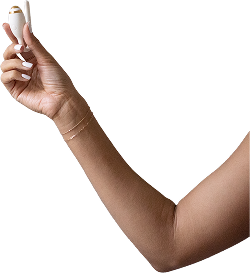Did you know you can use your hormones to work for you and not against you?
For us women, our hormones might feel like a roller-coaster during the typical 28-day cycle (or the length that is typical for you), but if we understand what happens with our hormones during these 28 days, we can embrace our hormones, and actually improve productivity!
When considering the phases of productivity of the cycle, it’s important to recognize the different phases of the cycle, the hormones at play, and how you can use them for your benefit.
Menstrual Phase (typically days 1-7)
During the menstrual phase, also known as your period, estrogen and progesterone are at their lowest. During this time of cycle, we need to stay low-key. It’s a good time to be creative and reassess your goals. With this fresh new cycle, perhaps you plan out your monthly goals and check-in on progress with other tasks and projects.
You don’t need to use your kegg during bleeding days. Just enter into the app, record your period and get ready to resume the usage of kegg once your period ends.

Follicular Phase (Days 8-13)
Estrogen and testosterone begin to rise during the follicular phase. Use this boost in estrogen to stimulate brain power and brainstorm or potentially work on a mentally challenging task. Got your sights set on accomplishing something particularly difficult? Now is the time to get to work and stay focused.
kegg detects electrolytes which change with the hormonal shifts. As the fertile window opens and estrogen rises, we see a descent in kegg readings. With kegg, you can see all of the days of your fertile window.
💡 TTC tip: If you are trying to conceive, this is the time to get ready. Most women get pregnant from intercourse that did NOT occur on the day of ovulation. Conception is more likely to occur from intercourse 2-3 days before ovulation. This is because when fertile CM is present, sperm can survive up to 5 days!

Ovulatory Phase (Days 14-16)
As ovulation rolls around, estrogen and testosterone are at their peak and it’s time to collaborate and communicate. Use this time of your cycle to network, go out on dates or host events. Consider this the social phase of the cycle.
Remember, to maximize your chances of conception, kegg’s job is to predict the full fertile window. kegg does not predict ovulation day and the lookback fertile window confirmation confirms the full fertile window duration and not ovulation day. However, after the fertile window is complete, you can review your fertile valley and suspect ovulation occurred on the first day of the rise, or the day preceding this.
💡TTC tip: since ovulation cannot be confirmed until after it has occurred, and the egg can survive for only 12-24 hours, trying to time intercourse on ovulation day is not only difficult but also limiting. While it is tempting to assume your ovulation was healthy looking at your fertile valley alone, keep in mind this does not confirm ovulation indeed occurred, or was adequate.

Luteal Phase (Days 17-28)
After ovulation, progesterone starts to peak and this is a good time of the cycle to be productive. You also don’t want to over-work yourself because your body is preparing to menstruate, so listen to your body.
Many users wonder if using kegg during the luteal phase can be beneficial. Although your predicted peak fertility might be already passed, kegg’s team always recommends looking out for potential delayed fertile window that can occur due to stress, traveling and many other reasons. (see example on the right)
💡 TTC tips: If you received Proov with your order, you can confirm ovulation by using your PdG test on days 7-10 after the rise in the fertile valley. Use the first day of the rise as day 1 of your count.


While kegg does not break down the phases of the cycle, you can identify these components by dividing your cycle data into four components: your period, the kegg readings before your fertile window, the fertile window, and the duration between the end of your fertile window and your next cycle start. Considering how these phases of your cycle impact your productivity, creativity, and socialization may also help pass the time while trying to conceive as you set forth to accomplish various creative and challenging tasks!
As we all know, our work and social calendars do not wait to sync with our cycles. Despite this, you can keep these phases and their impact on your productivity in mind as you plan your goals and social calendar to try to align with the phases of your cycle. Once you have an understanding of what happens with our hormones during the month, it’s easier to work with them, embrace them, and use them to your full advantage!
More About the Author
Dr. Ellis is a Naturopathic Doctor who helps women balance hormones, fix crappy periods and regain energy they once had to be their happiest, healthiest selves. In 2010 Dr. Ellis was diagnosed with a rare form of Non-Hodgkin’s Lymphoma which was the turning point in her life. Having had a cancer diagnosis at such a young age, Dr. Ellis’s mission is to empower those to take control of their health. Life is too short to feel sub-optimal and given the right tools, your body has the innate ability to heal itself. When she’s not empowering others to become their best versions, Dr. Ellis enjoys spending time helping her community, spending time with her dogs, having game nights with family and friends and making new memories with her Fireman.

You can reach Dr. Ellis at Dr. Erin Ellis-Naturopathic Doctor
Hope Natural Health
www.hopenaturalhealth.com
IG @hopenaturalhealth
FB @hopenaturalhealth
3336 E Chandler Heights Road Suite 123, Gilbert, AZ 85298
480-630-1665



